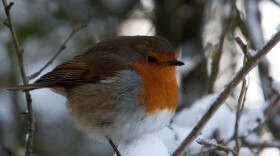Today we debut a new series of natural history commentaries, featuring scientists from two Northwoods field stations: UW-Madison’s Trout Lake and Kemp Research Stations.
Today researcher Susan Knight asks why some aquatic plants stay green all winter.
A couple of months ago, I was asked to write an article about how lake plants survive under the ice all winter. I knew that most aquatic plants are like our garden plants and die back to their roots in winter, and, even if they are still standing, they usually look rather black and unhealthy. But, there is one kind of plant I always wondered about. I’m talking about those tough, stubby little plants that tickle your toes on sandy-bottomed lakes in the summer. I suspected they might be evergreen - in the same way that pine or spruce trees are evergreen. These underwater plants seem to be bright green no matter how early in the spring you get out to check after the ice goes off. Still, I couldn’t find anything written that said they were evergreen. I asked my friend Paul Skawinski, who is even more of a plant nerd than I am, and he didn’t know either. So we decided to go out and look.

Looking for plants in winter is only slightly nuttier than looking for fish in winter, and requires pretty much the same equipment. Paul and I arranged to meet at Burrows Lake in Oneida County on a reasonably warm morning in late December. I brought the ice auger and a sled and Paul brought a fancy camera and flashlight mounted on a very un-fancy pole made of PVC pipe. The ice auger fired up nicely, but things went downhill from there. I was operating the auger and when it punched through the ice, the auger pulled me straight down and slammed me face first onto the ice. I was OK, but I did get quite a shiner.
Anyway, Paul attached his camera to the pole, set it to record video, turned on the light, and lowered the entire contraption into the water through the hole we had drilled. After about a minute, he pulled up the camera, and we huddled around to replay the video. AHA! The plants were green! Paul, the plant nerd, said “Why, its Schoenoplectus subterminalis”! That would be water bulrush to the rest of us, and this first finding was very exciting! There really were green plants under the ice!
After we were done filming, we lowered a long-handled, double-sided rake to grab some of the plants off the bottom so we were sure we were identifying them correctly; and we got some terrific still shots of the plants laid out on the snow. We then drove over to Big Carr Lake where, needless to say, Paul took over drilling the holes. We found lots more species of plants looking as green as they do in summer. This was really thrilling for a couple of botanists! We ended up also visiting Little Carr and McGrath, finding additional species in every lake.
Altogether we saw about a dozen species – including water lobelia, littorella and tiny little waterwort – all apparently as green as ever. So why do some lake plants stay green all winter? As cold as it feels, the temperature of the water under the ice is much warmer than the world above. Of course any plant that floats on the water or sticks out of the water, like pond lilies or cattails, can’t survive. But most of the leafy underwater plants cannot survive either, probably because there isn’t enough light to sustain them. As the winter goes on, the ice gets thicker, the snow gets deeper, and the light is cut down more and more each day. Even when the days start getting longer in January and February, there is probably less and less light under the ice until spring breakup.
But these little evergreen plants manage to stay green. They probably aren’t photosynthesizing much in the dead of winter, but they will be the first to get going come spring. So why are they evergreen? Like pines and spruce, it comes down to economics. The plants can’t afford to make new leaves every spring – it takes too much energy and too many nutrients. So they invest in leaves that last more than one season. But being evergreen comes at a cost. Most evergreen plants grow more slowly and they have adapted to grow in less hospitable places – at least from a plant’s point of view. These little evergreen lake plants don’t grow fast, but they are ready to go once the ice is gone, and the sun is shining down again.
It was great fun to spy on them through the ice, and we are planning another trip in March to see how they survived the winter.
Field Notes is brought to you monthly by UW-Madison's Trout Lake and Kemp Natural Resources Stations.











